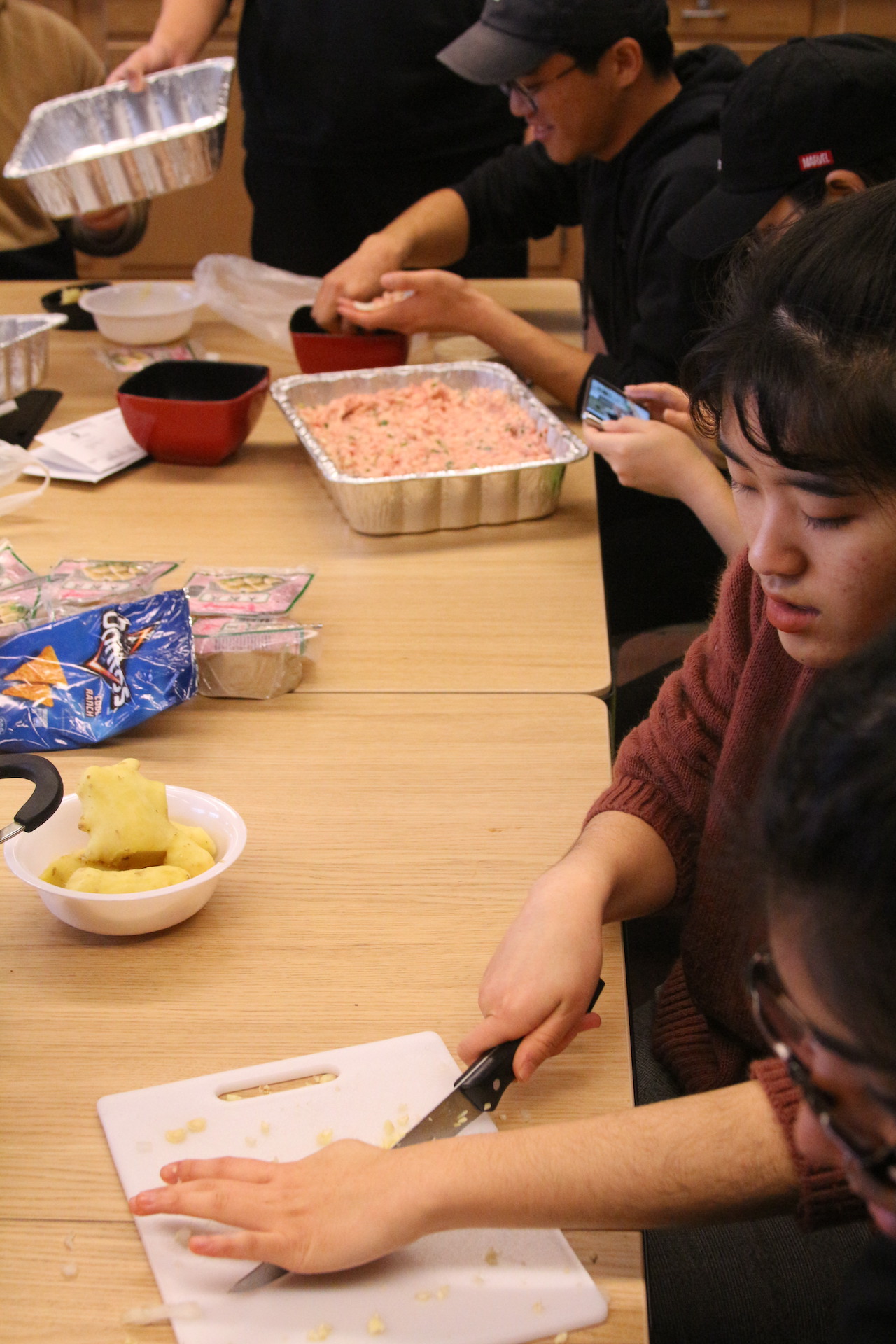There is more than one way to make a dumpling.
Some will first gather the dumpling wrapper in the palm of their hand, having already been perfectly rolled out into a circle, grab a pair of chopsticks, transfer the filling onto the center of the wrapper, and then with what appears to be muscle memory, fold the dough over into a crescent shape, pinching up the sides with one quick movement.Others will more slowly pick up the wrapper, place the filling on top, but then wrap the ends of the half-folded dumpling together in front to resemble a fortune cookie.
Either way will work.
Two dumplings complete, 298 more to go.
Thirteen members of the Asian Student Association (ASA) at Goshen College gathered Saturday morning to make nearly 300 dumplings in only three hours for the Lunar New Year celebration held on campus Saturday evening, Jan. 25. The event was first introduced last year after ASA was formed, but the traditions of the Lunar New Year, which celebrates the start of a new year according to the lunar calendar, can be traced back nearly 4,000 years ago in China’s history.
“Food is an inseparable part of every Lunar New Year celebration,” said Yejin Kim, a member of ASA. “And dumpling making is an old tradition in countries that celebrate the holiday.”
A dumpling is a piece of art; it’s creation and execution left up to the dumpling maker. The filling comes first, mincing fresh garlic and green onions along with blended ginger and chopped onions. A sea of whites and greens color the bowl. Whether vegetarian or meat-lover, one can then add tofu or ground pork. Finally, the salt and pepper are tossed into the mixture for added flavor.
Nearly an hour was spent perfecting the filling, with ASA president Rebecca Choi running back to her apartment to retrieve forgotten ingredients. The right taste is everything.
Students of ASA, those experienced in the art of dumpling making and those who still consider themselves amateurs, then began the process of preparing dumplings in a shape resembling that of a half moon.
“This tradition originates from China,” Kim said. “The half moon shape is also the shape of China’s ancient currency, Ingots, also known as Tael. They are eaten not only because of their deliciousness, but also to usher in wealth and good luck for the upcoming year.”
A second-generation Korean immigrant, Becca Choi identifies as Korean American and is the current president of ASA. She remembers growing up with the family celebration of the Lunar New Year.
“It is a tradition for us to make homemade dumplings and rice cake soup,” she said. “I first learned to make dumplings when I was in elementary school.”
Choi remembers the family record for total number of dumplings made in one sitting: 600.
“That includes help from extended family members,” she said.
Eden George, a junior from Bangalore, India, is marketing manager for ASA and also helped make dumplings for the event, but it is not a tradition she personally identifies with.
“I do think it depends on which country you are coming from, because everyone has different traditions,” she said. “We do it here in Goshen because it is the easiest thing to do that involves the help of other people, so we are able to build community.”
The dumplings, fried or steamed, were served at the Lunar New Year celebration, attended by nearly 130 students on campus. A long line wound through the halls of the Connector building, as students filled their plates with the handmade dumplings served alongside fried rice and spring rolls from local restaurants.
The Lunar New Year is widely celebrated in Asian countries, including, but not limited to China, Korea, Vietnam, Laos, Taiwan and Singapore. 21 students on GC’s campus currently identify as Asian.
“There are Asian and Asian American students on campus,” Choi said. “Having a support system and a group to empower other Asians is beneficial not only to the students, but also to the community.”
Bohan Lin, a sophomore from Zhejiang, China and a member of ASA, first learned to make dumplings when she was seven years old.
“I don’t know, maybe I was just born with a talent for making food,” she said.
The 300 dumplings made on Saturday morning weren’t enough for the appetite of the Saturday night attendants. Soon ASA members began frying more in the kitchen while the event was taking place, with music from Asian artists of the K-pop and Indian genres playing in the background.
“One cannot celebrate properly without food, and making the food becomes more meaningful and fun when there’s people that are helping to make it and people to share the food with,” Kim said.
Yejin Kim was a contributing writer for this piece.




